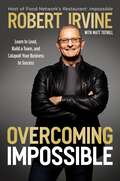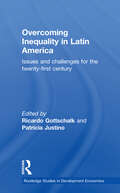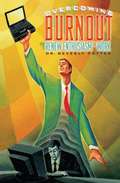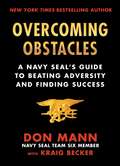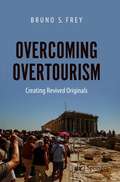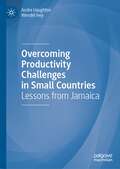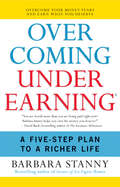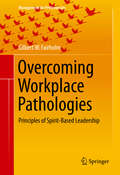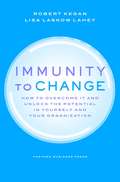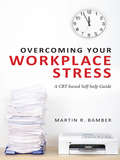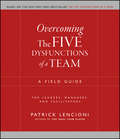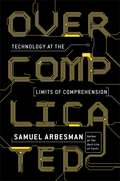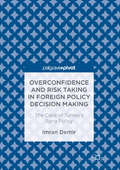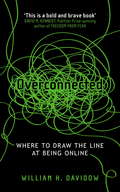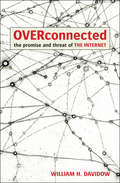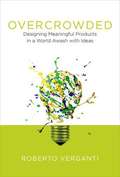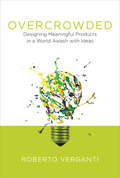- Table View
- List View
Overcoming Impossible: Learn to Lead, Build a Team, and Catapult Your Business to Success
by Robert IrvineMake achieving your goals and finding success possible with this one-of-a-kind guide by Robert Irvine, popular host of Food Network&’s Restaurant: Impossible.Robert Irvine knows a thing or two about business. For over 200 episodes of Food Network&’s hit show Restaurant: Impossible, he&’s helped failing entrepreneurs make the necessary changes to reverse course and transform their businesses from the brink of collapse to sustainable enterprises. And he doesn&’t just talk a good game; Irvine is a successful entrepreneur himself with a family of companies to his credit, from frozen foods and liquor to protein bars, restaurants, a traveling live show, and a namesake foundation that gives back to America&’s veterans and first responders.Now Irvine is sharing the success secrets he has learned along the way so he can help others thrive. As he says in the book: &“I&’ve always wanted to write this book, and now I finally have enough hindsight to analyze the moves that transformed me from an aspiring entrepreneur to a successful one.&” In this book, you will:Learn how to stop micromanaging.Understand what really motivates you, how to be accountable, and how to manage ego.Foster the traits of authenticity and trust into your culture.Change your mindset around technology and social media.
Overcoming Incumbent Challenges: How to Knock Down Organizational Barriers to Pursue New Directions
by Mark W. JohnsonCompanies innovate all the time: products, marketing efforts, efficiency. But rarely do incumbent companies make the leap to reinvent their existing business model or create new ones in response to opportunities in the white space-the range of potential activities outside a company's core and beyond its adjacencies. The prevailing business model is essential for managing and executing operations and innovation efforts focused on growing the core or pursuing adjacencies. But it can be poison to new business models. In this chapter, strategic innovation expert Mark Johnson shows how, using the four-box business model framework-customer value proposition (CVP), profit formula, key resources, and key processes-leaders can make plans for seizing transformational growth by setting expectations that are convincing and realistic in the larger corporate context. Johnson cites numerous company examples that illustrate the pitfalls that can stymie transformation efforts-and uses the example of Hilti to show how to get it right. This chapter was originally published as Chapter 8 of "Seizing the White Space: Business Model Innovation for Growth and Renewal."
Overcoming Inequality in Latin America: Issues and Challenges for the 21st Century (Routledge Studies in Development Economics)
by Ricardo Gottschalk Patricia JustinoLatin America is faced with the challenge of achieving the Millennium Developmental Goal to halve poverty in the region by 2015. Historically, this region has experienced persistently high levels of inequality and poverty, the causes and consequences of which are analytically examined here. Adopting a multidimensional approach, this informative book focuses on the mechanisms that lead to higher inequality and emphasizes the role of macroeconomics, trade rules, capital flows and the political electoral process. It analyzes how inequality has hindered development, how it interacts with a nation’s economic, social and political processes, and how inequality constrains these processes in ways that weakens the prospect of establishing and sustaining a dynamic, wealthy and creative society. An international team of specialist contributors investigate and explain these crucial issues. Examining the key economic policies and reforms which have exacerbated the region’s extremely high inequality levels, throughout this book they prescribe an alternative range of policy suggestions to help alleviate inequality and provide the foundations for more equitable development.
Overcoming Job Burnout
by Beverly A. PotterJob burnout is something that doesn't go away - especially in a chaotic economy. It is a kind of job depression caused by feelings of powerlessness - loss of control over one's work. The effect is devastating. The victim dreads going to work. Productivity falls and life becomes hell. Burnout is stressful, but it is not caused by stress. Going on a vacation provides relief until the vacation is over and one must return to the job. OVERCOMING JOB BURNOUT describes how burnout can take hold and how to turn it around. Docpotter offers 8 proven strategies for increasing personal power and renewing enthusiasm for working. Book is filled with practical advice that the reader can implement immediately.
Overcoming Obstacles and Finding Success: The Power of Performance Psychology
by Emily Pica Kevin R. HarrisThis valuable book identifies common obstacles in any endeavor that can impact on success and offers highly accessible exercises to help readers overcome them. Featuring expertise from dozens of high-level performers regarding their journey to the top of their domain, it offers practical advice on how to separate yourself from your competition and stand out from the crowd.All performers, whether beginners or world class, in sports, business, the arts, and beyond, have encountered obstacles in their careers. Acknowledging that every successful person must work hard, this book offers a blueprint for those wanting to map out their own success based on over twenty years of research into performance, and the authors’ experiences of guiding career development among their mentees and teaching courses on the topic. Each chapter includes a case study that exemplifies one of the most common obstacles individuals face in their efforts to be successful, including topics like impostor syndrome, artificial ceilings, facing rejection, and not allowing for rest or recovery. Following this, the chapter goes on to provide a series of engaging exercises for readers to reflect on their own performance and techniques, and enables them to strategize ways they can modify their performance to achieve better results. Throughout, the book is underpinned by theoretical frameworks from performance psychology, clear actionable steps for achieving success, and suggested readings for further study.Written with career development in mind, the applications of this book are far-reaching, with relevance for all those looking to excel in their chosen fields.
Overcoming Obstacles: A Navy SEAL's Guide to Beating Adversity and Finding Success
by Don Mann Kraig BeckerWisdom and inspiration to help you achieve your goals. A former Navy SEAL and current motivational speaker, Don Mann specializes in helping others achieve success in every aspect of life— personal and professional—by using techniques employed by Navy SEALs. In Overcoming Obstacles, Mann zeroes in on finding ways to conquer the obstacles that readers face in their lives, no matter what they may be. This volume includes three subsections dedicated to helping the reader surmount life’s difficulties: Identifying the Obstacles in Your LifeGetting Out of Your Own WayFinding Success Featuring practical advice, inspirational quotes, engaging stories, and interesting anecdotes, Overcoming Obstacles will give readers the tools they need to triumph in the face of adversity.
Overcoming Overtourism: Creating Revived Originals
by Bruno S. FreyCultural Overtourism is a comparatively new term, and refers to historical sites, museums and places that are extremely crowded by tourists; hence, a type of tourism that has negative effects on both the cultural sites and the people who live there. This problem has sparked more and more protests. Accordingly, many cultural institutions and cities are now taking measures to limit the flow of tourists. In this book, Bruno S. Frey - a renowned and frequently cited economist - suggests, on the contrary, an extension of the supply of cultural sites in the form of “Revived Originals”. By this he means the erection of identical replicas of the most important buildings at a suitable nearby location. In addition, digital information technologies (augmented and virtual reality including holograms) can be used to immerse visitors in the history and culture of the newly established sites, while adjacent hotels, restaurants and shops provide the necessary accompanying infrastructure. In this way, the flow of tourists can be distributed between the original site and the Revived Original. This book outlines the “Revived Originals” concept, discusses the organisational and economic challenges it entails, and contrasts it with existing Disneyland concepts. Especially for families with children or people who have little interest in culture - i.e., for the majority of visitors - these places can be very attractive. This book will appeal to anyone interested in alternative forms of tourism, as well as political and administrative decision-makers looking for new solutions to cultural overtourism.
Overcoming Productivity Challenges in Small Countries: Lessons from Jamaica
by Andre Haughton Wendel IveyProductivity growth has been slowing down globally in recent years in light of heightened economic crises and geopolitical tensions. This book puts the issue of low productivity growth in small countries under a microscope, exploring Jamaica’s productivity challenges in its quest to achieve its United Nation Sustainable Developmental Goals. Overall, this book provides useful examples of handicaps that small countries face and proposes different approaches in finding plausible solutions to their overarching productivity challenges. This study provides useful lessons to other countries, as well, which would like to transition from developing to developed and to better the lives of their citizens.
Overcoming Resistance: A Practical Guide to Producing Change in the Workplace
by Jerald M. Jellison"A clear, concise, and useable guide to making change happen." - Martha Gates, Vice President, Pacific Mutual Life Insurance
Overcoming Underearning(TM)
by Barbara StannyWhen it comes to money, are you controlled by fear? Do you live in financial chaos?Do you underestimate your worth? Are you ready to go to the next level, but can't seem to get there? If the answer is yes to these questions, you may be an underearner. Underearners are self-saboteurs who never live up to their earnings potential, says Barbara Stanny, a financial educator, motivational speaker, former journalist, and career counselor. Underearners tend to live paycheck to paycheck. They rarely balance their checkbooks and are often in debt. Ironically, many work incredibly hard. Yet they are ashamed to admit that money matters to them. They all have a high tolerance for low pay. The good news is that underearning is often self-imposed. By focusing on overcoming underearning, you will not only earn what you deserve, but you can live up to your full potential. With techniques and exercises that have helped thousands of people who have participated in her Overcoming Underearning workshops, Stanny teaches you five essential steps to financial independence. Once you understand these steps, you will be confident asking for a raise, increasing your prices, or getting a better job. "Now I'm making more than my friends, all because I had the guts to dream and ask for more," says one Stanny fan. First, Tell the Truth: be honest about your financial situation and figure out your attitudes toward money. Second, Make a Decision: decide that you want to make more money. Third, Stretch: take action, face your fears, and be willing to be uncomfortable. Fourth, Create Community by finding supporters and asking for help. Fifth, Respect and Appreciate Money: learn to save and invest. Overcoming Underearning is filled with inspiring, real-life stories of underearners who turned their lives around. Stanny brings a message of empowerment and hope to all those who chronically undervalue themselves. "I'm making more, working less, feeling healthier, have more energy, and I'm so much happier," concludes another Stanny believer.
Overcoming Underearning(TM)
by Barbara StannyWhen it comes to money, are you controlled by fear? Do you live in financial chaos?Do you underestimate your worth? Are you ready to go to the next level, but can't seem to get there? If the answer is yes to these questions, you may be an underearner.Underearners are self-saboteurs who never live up to their earnings potential, says Barbara Stanny, a financial educator, motivational speaker, former journalist, and career counselor. Underearners tend to live paycheck to paycheck. They rarely balance their checkbooks and are often in debt. Ironically, many work incredibly hard. Yet they are ashamed to admit that money matters to them. They all have a high tolerance for low pay.The good news is that underearning is often self-imposed. By focusing on overcoming underearning, you will not only earn what you deserve, but you can live up to your full potential. With techniques and exercises that have helped thousands of people who have participated in her Overcoming UnderearningTM workshops, Stanny teaches you five essential steps to financial independence. Once you understand these steps, you will be confident asking for a raise, increasing your prices, or getting a better job. "Now I'm making more than my friends, all because I had the guts to dream and ask for more," says one Stanny fan.First, Tell the Truth: be honest about your financial situation and figure out your attitudes toward money. Second, Make a Decision: decide that you want to make more money. Third, Stretch: take action, face your fears, and be willing to be uncomfortable. Fourth, Create Community by finding supporters and asking for help. Fifth, Respect and Appreciate Money: learn to save and invest.Overcoming Underearning is filled with inspiring, real-life stories of underearners who turned their lives around. Stanny brings a message of empowerment and hope to all those who chronically undervalue themselves. "I'm making more, working less, feeling healthier, have more energy, and I'm so much happier," concludes another Stanny believer.
Overcoming Workplace Pathologies
by Gilbert W. FairholmThis book deals directly with the characteristics of the relationships that the leader builds in the context of the work environment. It argues that the prevailing work community work culture is intended to help the leader lead but, increasingly it impedes the leader's work. Leadership is a function of the leader's values, attitudes, and aspirations: leadership flows from the leader's spiritual character-defining core essence. However, the author argues that cultural forces coming from both inside and outside the workplace, often designed to promote diversity, inclusivity, and tolerance, have introduced into the work culture values and behavior that are pathological to executing effective leadership and detrimental to the health of work communities. While attractive on the surface, these new values are toxic to the idea of relationship and thus threaten the work community culture, in effect "killing leadership. " This book will arm leaders with the tools, resources, and techniques to recognize and overcome workplace pathologies. After reading this book, leaders will: have a complete understanding of the key principles of spirit-based values leadership see clearly that the leader's values shape both the leader's one-on-one relationships with coworkers and are at the center of the work culture they create to re-enforce coworker actions and decisions appreciate more fully the power of the ambient work culture to influence coworkers toward leader set values and methods guiding the work community know the toxic effect on doing leadership of introducing non-work values and standards into the work community culture understand the arguments against allowing subgroups of the work community to form and practice values opposed to the values the leader has set for the full group be better prepared to deal with the consequences of encountering evil, hatred and/or fear in the workplace realize that not all coworkers are uniformly honest and truthful and learn ways to counter this behavior and still accomplish the work community's goals and ensure its productivity The result is a pragmatic approach to aligning values, behaviors, and performance, while enhancing the principles of effective and positive leadership throughout the organization.
Overcoming Your Immunity to Change
by Lisa Laskow Lahey Robert KeganSeeing how your self-protective motivations systematically prevent you from achieving exactly what you most desire is necessary. Insights can be powerful, even exciting, but they do not necessarily lead to transformation. You need a structure to help channel your aspirations, test and gain distance from your assumptions, and steadily build a new set of strategies for bridging the gap between your intentions and behavior. This chapter outlines a process for overcoming your immunity to change once the problem has been diagnosed. This chapter is excerpted from "Immunity to Change: How to Overcome It and Unlock the Potential In Yourself and Your Organization."
Overcoming Your Workplace Stress: A CBT-based Self-help Guide
by Martin R. BamberOccupational stress affects millions of people every year and is not only costly to the individual – in terms of their mental and physical health – but also results in major costs for organisations due to workplace absence and loss of productivity. This Cognitive Behaviour Therapy (CBT) based self-help guide will equip the user with the necessary tools and techniques to manage work related stress more effectively. Divided into three parts, this book will help you to: understand occupational stress learn about a range of methods to reduce stress levels develop your own self-help plan. Overcoming Your Workplace Stress is written in a straightforward, easy-to-follow style, allowing the reader to develop the necessary skills to become their own therapist.
Overcoming the Five Dysfunctions of a Team: A Field Guide for Leaders, Managers, and Facilitators (J-B Lencioni Series #16)
by Patrick M. LencioniIn the years following the publication of Patrick Lencioni's best-seller The Five Dysfunctions of a Team, fans have been clamoring for more information on how to implement the ideas outlined in the book. In Overcoming the Five Dysfunctions of a Team, Lencioni offers more specific, practical guidance for overcoming the Five Dysfunctions--using tools, exercises, assessments, and real-world examples. He examines questions that all teams must ask themselves: Are we really a team? How are we currently performing? Are we prepared to invest the time and energy required to be a great team? Written concisely and to the point, this guide gives leaders, line managers, and consultants alike the tools they need to get their teams up and running quickly and effectively.
Overcoming the Groupwide Immunity to Change: A Collective Approach
by Lisa Laskow Lahey Robert KeganIndividuals and collectivities like work teams, leadership groups, departmental units, and whole organizations often unknowingly protect themselves from making the very changes they most want to make. They fall victim to a phenomenon the authors call "immunity to change." This chapter follows a number of teams and work groups as they explore their own immunity to change at the level of both individual group members and the group as a whole. This chapter is excerpted from "Immunity to Change: How to Overcome It and Unlock the Potential In Yourself and Your Organization."
Overcoming the Retributive Nature of the Israeli-Palestinian Conflict
by Thomas L. Saaty Luis G. Vargas H. J. Zoffer Amos GuioraThis book presents an interdisciplinary approach to conflict solution focusing on a very specific type of conflict, retributive conflicts . It is unique in the treatment of these and how relative measurement is used to find equilibrium solutions. The authors present an alternative process to address the Israeli-Palestinian conflict. They do so in two ways that are different from past efforts. The first is by formally structuring the conflict and the second is the manner in which discussions were conducted and conclusions drawn. The approach will help create a solution and provide negotiators with a unique pathway to consider the thorny issues and corresponding concessions underlying the deliberations, together with their implementation. The Analytic Hierarchy Process (AHP) provides a way to conflict solution with the participation of negotiators for the parties. It is a positive approach that makes it possible to reason and express feelings and judgments with numerical intensities to derive priorities. With the assistance of panels of Israeli participants and Palestinian participants brought together in 2006 to 2017, AHP was applied for the first time in a group setting to the Palestinian-Israeli conflict. The process makes it clear that moderation in different degrees by both sides is essential to arrive at acceptable agreements on concessions proposed and agreed upon by both sides.
Overcomplicated: Technology at the Limits of Comprehension
by Samuel ArbesmanWhy did the New York Stock Exchange suspend trading without warning on July 8, 2015? Why did certain Toyota vehicles accelerate uncontrollably against the will of their drivers? Why does the programming inside our airplanes occasionally surprise its creators? After a thorough analysis by the top experts, the answers still elude us. You don't understand the software running your car or your iPhone. But here's a secret: neither do the geniuses at Apple or the Ph.D.'s at Toyota--not perfectly, anyway. No one, not lawyers, doctors, accountants, or policy makers, fully grasps the rules governing your tax return, your retirement account, or your hospital's medical machinery. The same technological advances that have simplified our lives have made the systems governing our lives incomprehensible, unpredictable, and overcomplicated. In Overcomplicated, complexity scientist Samuel Arbesman offers a fresh, insightful field guide to living with complex technologies that defy human comprehension. As technology grows more complex, Arbesman argues, its behavior mimics the vagaries of the natural world more than it conforms to a mathematical model. If we are to survive and thrive in this new age, we must abandon our need for governing principles and rules and accept the chaos. By embracing and observing the freak accidents and flukes that disrupt our lives, we can gain valuable clues about how our algorithms really work. What's more, we will become better thinkers, scientists, and innovators as a result. Lucid and energizing, this book is a vital new analysis of the world heralded as "modern" for anyone who wants to live wisely.
Overcomplicated: Technology at the Limits of Comprehension
by Samuel ArbesmanWhy did the New York Stock Exchange suspend trading without warning on July 8, 2015? Why did certain Toyota vehicles accelerate uncontrollably against the will of their drivers? Why does the programming inside our airplanes occasionally surprise its creators? After a thorough analysis by the top experts, the answers still elude us. You don’t understand the software running your car or your iPhone. But here’s a secret: neither do the geniuses at Apple or the Ph.D.’s at Toyota—not perfectly, anyway. No one, not lawyers, doctors, accountants, or policy makers, fully grasps the rules governing your tax return, your retirement account, or your hospital’s medical machinery. The same technological advances that have simplified our lives have made the systems governing our lives incomprehensible, unpredictable, and overcomplicated. In Overcomplicated, complexity scientist Samuel Arbesman offers a fresh, insightful field guide to living with complex technologies that defy human comprehension. As technology grows more complex, Arbesman argues, its behavior mimics the vagaries of the natural world more than it conforms to a mathematical model. If we are to survive and thrive in this new age, we must abandon our need for governing principles and rules and accept the chaos. By embracing and observing the freak accidents and flukes that disrupt our lives, we can gain valuable clues about how our algorithms really work. What’s more, we will become better thinkers, scientists, and innovators as a result. Lucid and energizing, this book is a vital new analysis of the world heralded as "modern" for anyone who wants to live wisely.
Overcomplicated: Technology at the Limits of Comprehension
by Samuel ArbesmanWhy did the New York Stock Exchange suspend trading without warning on July 8, 2015? Why did certain Toyota vehicles accelerate uncontrollably against the will of their drivers? Why does the programming inside our airplanes occasionally surprise its creators? After a thorough analysis by the top experts, the answers still elude us. You don't understand the software running your car or your iPhone. But here's a secret: neither do the geniuses at Apple or the Ph.D.'s at Toyota--not perfectly, anyway. No one, not lawyers, doctors, accountants, or policy makers, fully grasps the rules governing your tax return, your retirement account, or your hospital's medical machinery. The same technological advances that have simplified our lives have made the systems governing our lives incomprehensible, unpredictable, and overcomplicated. In Overcomplicated, complexity scientist Samuel Arbesman offers a fresh, insightful field guide to living with complex technologies that defy human comprehension. As technology grows more complex, Arbesman argues, its behavior mimics the vagaries of the natural world more than it conforms to a mathematical model. If we are to survive and thrive in this new age, we must abandon our need for governing principles and rules and accept the chaos. By embracing and observing the freak accidents and flukes that disrupt our lives, we can gain valuable clues about how our algorithms really work. What's more, we will become better thinkers, scientists, and innovators as a result. Lucid and energizing, this book is a vital new analysis of the world heralded as "modern" for anyone who wants to live wisely. From the Hardcover edition.
Overconfidence and Risk Taking in Foreign Policy Decision Making
by Imran DemirThis book introduces a new perspective on risk seeking behaviour, developing a framework based on various cognitive theories, and applying it to the specific case-study of Turkey's foreign policy toward Syria. The author examines why policy makers commit themselves to polices that they do not have the capacity to deliver, and develops an alternative theoretical model to prospect theory in explaining risk taking behaviour based on the concept of overconfidence. The volume suggests that overconfident individuals exhibit risk seeking behaviour that contradicts the risk averse behaviour of individuals in the domain of gain, as predicted by prospect theory. Using a set of testable hypothesis deduced from the model, it presents an empirical investigation of the causes behind Turkish decision makers' unprecedented level of risk taking toward the uprising in Syria and the consequences of this policy.
Overconnected: The Promise and Threat of the Internet
by William H. DavidowIn Feb 2006, a Danish newspaper printed twelve highly provocative caricatures of the prophet Muhammad. The drawings landed on the internet and quickly circled the globe. As a direct result, riots ensued and at least 139 people died. This is just one example of overconnection. The consequences of an over-connected world cannot be ignored. In this important book, William H. Davidow takes a highly pragmatic approach by recognising that the digital clock cannot be turned back in terms of ubiquitous connectivity, but urges that caution and forethought is applied to the systems we build in the future. Davidow identifies four distinct levels of connection: Underconnected, Interconnected, Highly Connected and Overconnected. Highly Connected is the ideal state we must strive for and avoid spilling into Overconnected.
Overconnected: The Promise and Threat of the Internet
by William H. Davidow&“Shows how the unanticipated effects of the Internet are distorting economics, politics, international relations, and individual lives&” (James Fallows). In Overconnected, Bill Davidow, a former Silicon Valley executive, explains how the almost miraculous success of the Internet has also created a unique set of hazards, in effect overconnecting us, with the direst of consequences for our political, economic, and day-to-day lives. The practical applications—not least among them the ability to borrow money, invest in the stock market, or buy a new home—have made a great impact in our daily lives. But the luxuries of the connected age have taken on a momentum all of their own, ultimately becoming the root cause of a financial meltdown from which much of the world is now still struggling to recover. By meticulously and counter-intuitively anatomizing how being overconnected tends to create systems of positive feedback that have largely negative consequences, Davidow explains everything from the subprime-mortgage crisis to the meltdown of Iceland, from the loss of people&’s privacy to the spectacular fall of the stock market that forced the Federal Government to rescue institutions supposedly &“too big to fail.&” All because we were so miraculously wired together! Explaining how such symptoms of Internet connection as unforeseeable accidents and thought contagions acted to accelerate the downfall and make us permanently vulnerable to catastrophe, Davidow places our recent experience in historical perspective and offers a set of practical steps to minimize similar disasters in the future. Original, commonsensical and historically informed, Overconnected indentifies problems we live with that are now so large, omnipresent and part of our daily lives that few people have even noticed them.
Overcrowded: Designing Meaningful Products in a World Awash with Ideas
by Roberto VergantiThe standard text on innovation advises would-be innovators to conduct creative brainstorming sessions and seek input from outsiders -- users or communities. This kind of innovating can be effective at improving products but not at capturing bigger opportunities in the marketplace. In this book Roberto Verganti offers a new approach -- one that does not set out to solve existing problems but to find breakthrough meaningful experiences. There is no brainstorming -- which produces too many ideas, unfiltered -- but a vision, subject to criticism. It does not come from outsiders but from one person's unique interpretation. The alternate path to innovation mapped by Verganti aims to discover not how things work but why we need things. It gives customers something more meaningful -- something they can love. Verganti describes the work of companies, including Nest Labs, Apple, Yankee Candle, and Philips Healthcare, that have created successful businesses by doing just this. Nest Labs, for example, didn't create a more advanced programmable thermostat, because people don't love to program their home appliances. Nest's thermostat learns the habits of the household and bases its temperature settings accordingly. Verganti discusses principles and practices, methods and implementation. The process begins with a vision and proceeds through developmental criticism, first from a sparring partner and then from a circle of radical thinkers, then from external experts and interpreters, and only then from users. Innovation driven by meaning is the way to create value in our current world, where ideas are abundant but novel visions are rare. If something is meaningful for both the people who create it and the people who consume it, business value follows.
Overcrowded: Designing Meaningful Products in a World Awash with Ideas (Design Thinking, Design Theory)
by Roberto VergantiA more powerful innovation, which seeks to discover not how things work but why we need things. The standard text on innovation advises would-be innovators to conduct creative brainstorming sessions and seek input from outsiders—users or communities. This kind of innovating can be effective at improving products but not at capturing bigger opportunities in the marketplace. In this book Roberto Verganti offers a new approach—one that does not set out to solve existing problems but to find breakthrough meaningful experiences. There is no brainstorming—which produces too many ideas, unfiltered—but a vision, subject to criticism. It does not come from outsiders but from one person's unique interpretation. The alternate path to innovation mapped by Verganti aims to discover not how things work but why we need things. It gives customers something more meaningful—something they can love. Verganti describes the work of companies, including Nest Labs, Apple, Yankee Candle, and Philips Healthcare, that have created successful businesses by doing just this. Nest Labs, for example, didn't create a more advanced programmable thermostat, because people don't love to program their home appliances. Nest's thermostat learns the habits of the household and bases its temperature settings accordingly.Verganti discusses principles and practices, methods and implementation. The process begins with a vision and proceeds through developmental criticism, first from a sparring partner and then from a circle of radical thinkers, then from external experts and interpreters, and only then from users.Innovation driven by meaning is the way to create value in our current world, where ideas are abundant but novel visions are rare. If something is meaningful for both the people who create it and the people who consume it, business value follows.
